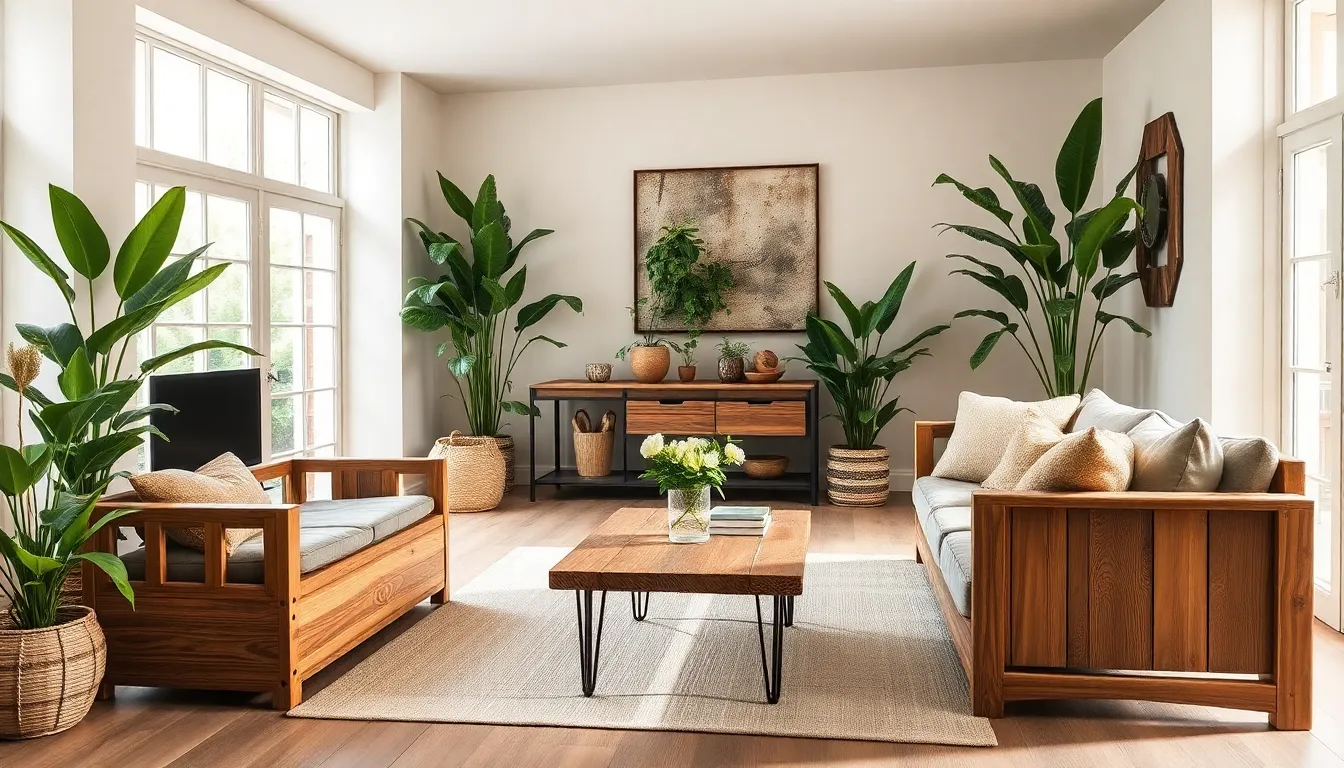In a world where style often clashes with sustainability, eco-friendly furniture is here to save the day—one chic chair at a time. Imagine lounging on a sofa that not only cradles you in comfort but also hugs a tree or two. With a growing number of designers embracing environmentally friendly materials, it’s easier than ever to furnish a home that’s as kind to the planet as it is to the eye.
Table of Contents
ToggleWhat Is Eco-Friendly Furniture?
Eco-friendly furniture refers to items made with sustainable materials and processes that minimize environmental impact. Such pieces often utilize renewable resources, such as bamboo or reclaimed wood, reducing the need for deforestation. Manufacturers create these products using non-toxic finishes and adhesives, ensuring safety for both consumers and the environment.
Designers increasingly adopt eco-conscious practices, focusing on longevity and recyclability. Sustainable furniture often features minimalistic designs, which not only enhance aesthetics but also emphasize function. Many eco-friendly options incorporate biodegradable fabrics like organic cotton or linen, further contributing to a reduced carbon footprint.
Purchasing eco-friendly furniture supports a circular economy that values sustainability. Consumers increasingly prefer products that align with their environmental values, prompting more manufacturers to shift towards greener options. Additionally, many eco-friendly pieces boast unique characteristics, resulting from the use of recycled materials or handcrafted techniques.
Choosing eco-friendly furniture promotes healthier indoor environments. This type of furniture minimizes exposure to harmful chemicals commonly found in traditional furniture production. As attitudes towards sustainability continue to evolve, the demand for eco-friendly designs will likely increase, shaping future trends in the furniture industry.
Benefits of Eco-Friendly Furniture

Eco-friendly furniture offers distinct advantages that appeal to both consumers and the environment. Many of these benefits revolve around sustainability and health.
Environmental Impact
Eco-friendly furniture reduces waste by utilizing sustainable materials, promoting a circular economy. Reclaimed wood and bamboo are popular choices; both materials regenerate quickly while minimizing deforestation. Manufacturers often use non-toxic finishes and adhesives, significantly lowering harmful emissions. These practices lead to reduced carbon footprints during production and transportation. In addition, this furniture typically features designs that enhance recyclability, which limits landfill waste. By choosing eco-friendly options, consumers contribute to preserving ecosystems and biodiversity.
Health Benefits
Consumer health improves significantly when opting for eco-friendly furniture. Traditional furniture often includes harmful chemicals, such as formaldehyde, which can lead to indoor air pollution. Furniture made with sustainable materials mitigates exposure to toxic substances, creating safer living environments. Non-toxic finishes ensure that harmful volatile organic compounds (VOCs) are minimized, improving air quality. Increased use of natural materials also encourages better overall well-being. Additionally, the handcrafted nature of many eco-friendly pieces often results in unique designs that foster a sense of connection to the environment.
Materials Used in Eco-Friendly Furniture
Eco-friendly furniture incorporates materials that minimize environmental impact. These sustainable options contribute to healthier homes and a cleaner planet.
Sustainable Wood Options
Sustainable wood options include species like bamboo, which grows rapidly and requires minimal resources. Reclaimed wood also offers benefits, as it repurposes old materials, reducing deforestation. Certified woods, such as those meeting the Forest Stewardship Council (FSC) standards, ensure responsible harvesting practices. Choosing these woods supports ecosystems and promotes biodiversity while providing durability in furniture design. Additionally, manufacturers frequently highlight the aesthetic appeal of sustainable woods, combining beauty with environmental consciousness.
Recycled Materials
Recycled materials play a significant role in eco-friendly furniture manufacturing. Various furniture designs utilize recycled plastics and metals, significantly reducing waste and lowering carbon footprints. These materials undergo extensive processing to ensure quality, allowing designers to create stylish and functional pieces. Upcycled materials also find their way into furniture production, transforming discarded items into unique pieces. By incorporating recycled materials, manufacturers decrease the demand for new resources, further promoting sustainability in the industry.
Biodegradable Fabrics
Biodegradable fabrics are an essential aspect of eco-friendly furniture. Natural fibers like organic cotton, linen, and hemp decompose better than synthetic alternatives, minimizing landfill impact. Using plant-based materials ensures non-toxic finishes and contributes to higher indoor air quality. Fabrics made from recycled sources, like post-consumer plastic bottles, combine sustainability with innovative design. Manufacturers often seek out these sustainable fabrics to create soft furnishings that align with eco-conscious values while maintaining aesthetic appeal.
Tips for Choosing Eco-Friendly Furniture
Selecting eco-friendly furniture involves considering several factors that enhance both sustainability and design. Prioritizing features ensures an informed decision that supports environmental health.
Certifications to Look For
Seek certifications that indicate a product’s eco-friendliness. Look for labels such as the Forest Stewardship Council (FSC) for sustainable wood sourcing. The Global Organic Textile Standard (GOTS) is essential for organic fabrics. Additionally, the GREENGUARD certification indicates low chemical emissions, contributing to better indoor air quality. Products bearing these certifications reflect responsible manufacturing practices that minimize ecological impacts.
Style and Functionality
Evaluate both style and functionality when choosing eco-friendly furniture. Select designs that seamlessly integrate with your home décor while maintaining sustainability. Consider minimalistic pieces that enhance aesthetics without excess materials. Versatile furniture offers practical benefits, such as multi-functionality, making it easier to adapt to various living spaces. Prioritize timeless designs, as they promote longevity and reduce the frequency of replacements.
Choosing eco-friendly furniture is more than just a trend; it’s a commitment to a healthier planet and home. By selecting pieces made from sustainable materials and non-toxic finishes, consumers not only enhance their living spaces but also contribute to a greener future. The unique designs and craftsmanship found in eco-friendly furniture foster a deeper connection to nature, making each piece special. As the demand for sustainable options grows, manufacturers are increasingly embracing eco-conscious practices. This shift not only benefits the environment but also promotes better indoor air quality and overall well-being. Embracing eco-friendly furniture is a step towards a sustainable lifestyle that reflects personal values and supports a thriving planet.


